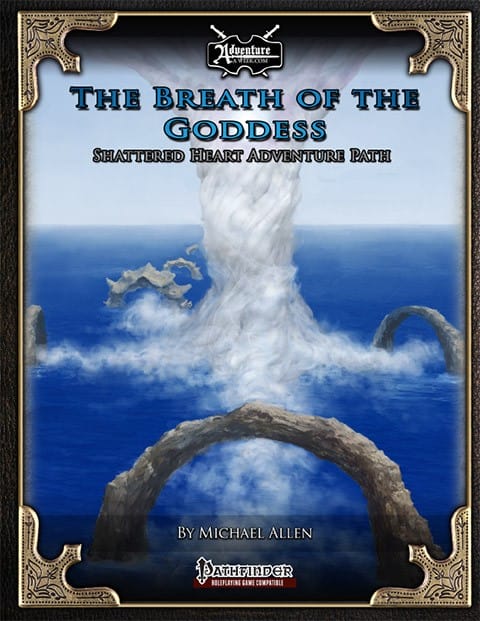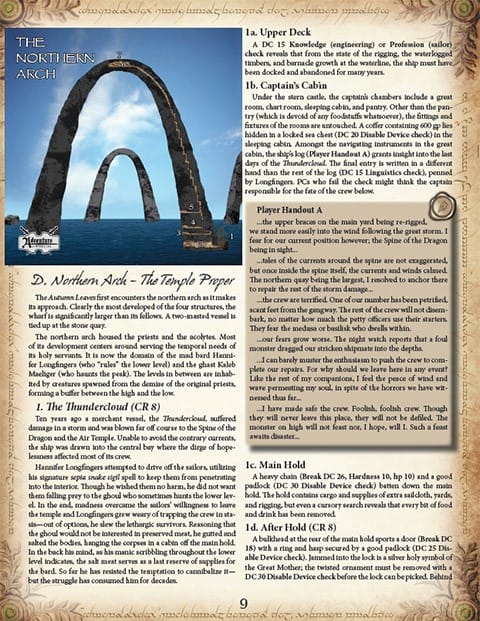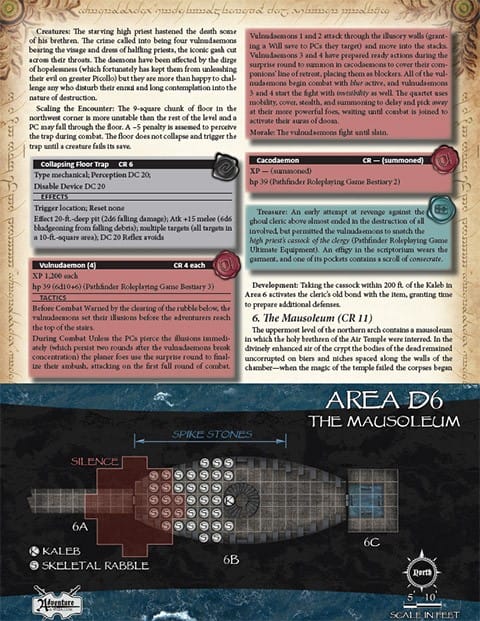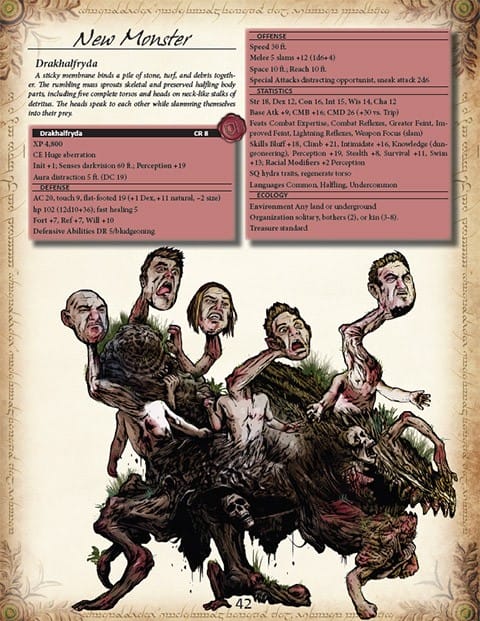| Format | |
|---|---|
| Level | |
| Author |
Shattered Heart Adventure Path #3: Breath of the Goddess
By Michael Allen
A tale of madness, death, life, and revelation for four to five 8th level player characters.
The ancient worship of the Great Mother continues its renaissance on the broken island of halfling Picollo. Will the engineers of its rebirth fall prey to heresy and false promise, or with they stand true to the tenets of community and joy?
The lost archipelago of Picollo now lies under the waves deep in the southern seas, buried under the body of the Dracoprime. In the area known as The Spine of the Dragon, the ancient temple to the air aspect of the Great Mother still stands, shrouded in mystery and superstition. A mission to reclaim the site shortly after the end of the Hoyrall Wars was aborted prematurely without discovering the fate of the priests once serving the goddess at this mystical site. The madness of the past seeks to trap the heroes as they venture forth to uncover the mysteries therein, and the madness of the present seeks to hide the truths lurking under the breath of the goddess.
Also included in this adventure:
- Engineering puzzles and challenges to test the monument building skills of your players.
- A new monster, the Drakhalfryda: a terrible byproduct of the Dracoprime’s plummet into southern Aventyr.
- Five new magic items and two magical boons (for those willing to pay the price).
- A method to track the PCs’ influence on the future
$9.99
1 review for Shattered Heart Adventure Path #3: Breath of the Goddess
This site uses Akismet to reduce spam. Learn how your comment data is processed.
Related Products
-
Pathfinder
Shattered Heart Adventure Path #1: Ties that Bind
Rated 5.00 out of 5$9.99Original price was: $9.99.$4.99Current price is: $4.99. Add to cart -
Pathfinder
Shattered Heart Adventure Path #2: The Temple of Jewels and Mirrors
Rated 5.00 out of 5$9.99Original price was: $9.99.$8.99Current price is: $8.99. Add to cart -
Pathfinder
Shattered Heart Adventure Path #4: Crucible of Faith
$9.99 Add to cartRated 5.00 out of 5



















Thilo Graf (verified owner) –
An Endzeitgeist.com review
The third installment of the so far truly superb Shattered Heart-saga clocks in at 63 pages, 1 page front cover, 1 page editorial, 1 page ToC, 2 pages of SRD, 1 page back cover, leaving us with a massive 57 pages of content, so let’s take a look!
This being an adventure-review, the following contains SPOILERS. Potential players of this saga should jump to the conclusion.
…
..
.
All right, still here? Great! When the continent-sized Dracoprime fell, the halflings of the idyllic island archipelago suffered; abandoned by their erstwhile allies, the culture that developed twists familiar tropes: Medium-sized humanoids, indentured workers (slaves by another name) became one of the few contacts to other races and xenophobia thrived. When the redeemed cleric Carlyetta recruited the PCs to re-establish the tree-temples of the great mother, the PCs were in for quite a culture shock as they learned about the eldermoot, social structures and the culture of the archipelago. However, as often, dark forces scheme and plan and the quest to restore the temples is fraught with perils – as the PCs embark to the third of these temples, they get a great first glance look at the cataclysmic, almost imaginable proportions that haunted the halflings.
The temple of air is perhaps one of the most unique structures to ever grace the pages of a module: Picture 4 titanic arcs rising from the sea, arcs that channel raging winds into a massive, miles-high tree-shaped titanic structure of clouds. Now picture one of these arcs broken, smashed by continent-sized bones of the legendary Dracoprime, with ancient bone-protrusions emerging from the rugged waves – it is this vista that graces the PCs and re-establishing the temple properly will not be easy.
Each of the arcs sports means of anchoring, sure – provided they can prevent their vessel from crashing while docking, but it is one in particular the PCs will have to explore – and it is here they’ll be greeted by a sight most ominous, as pickled corpses dangle in the wind and screeching screams emit from the eternal storm. This is the handiwork of a well-meaning, but utterly insane bard and as the PCs explore the complex, they’ll find scenes of grisly butchering and stumble over multiple sepia snake sigils placed to halt the progress of explorers. With a deranged stalker, the PCs bear witness to a tale of woe, as the last days of the halfling clergy is conveyed via ample amounts of journals, as they try hard to piece together the use of strange artifacts. Beyond the stalking adversary and lethal outsiders awaiting in the complex, this whole section can be considered one gigantic puzzle – not a puzzle in the traditional way, but in the act of exploration – as the PCs explore the complex, more and more pieces of information are gathered in the all but abandoned halls and from these, alongside their own knowledge, may they deduce how to restore the temple to former glory…if they are not wasted away by the scouring, maddening winds that begin to drive them insane the moment they arrived. It should be noted that the insane bard can be saved – and smart PCs better should do so.
Why? Well, for one, like the previous books, the community point tracker is always there in the background, tracking transgressions and kindness as a kind of meter for how, by action, they can influence not only Carlyetta, but the very soul of the halfling people of Piccolo. The insane bard knows – he knows about the fall of the last cleric, who has buried himself upstairs in the arc after cannibalizing his brethren – and it is due to this foe that the poor man pickled the corpses, tried to make them unpalatable for the ravenous undead…who awaits upstairs, buried alive by his own hand. (And yes, there are alternate ways to learn about him.) Now I mentioned outsiders…well, there is a brutal and glorious encounter: You see, these fellows have illusions…and the pdf actually provides a map for the illusion into which the PCs stumble! Map-wise, the presence of the like goes above and beyond – kudos indeed, this is what I always wanted to see!
Now the tainted, perverted undead does have a mob of undead (rules all too seldom used) and does look a bit like a “boss” for the module…and he is. However, the true challenge lies, ultimately, in research of the arch, in putting the pieces together – like Indiana Jones exploring an ancient ruin, the strange archeology that is the leitmotif here is absolutely unique and hearkens back to the wild-eyed exploration of ruins in old-school modules…only that now, we have degrees of skill-check-failures to determine functionality, various means of upgrading skills via learned knowledge…etc. Sure, your maxed out scholar character has a chance to know on his own how to use components required to repair the temple…but if you lack such a character, you’ll still have a lot of information to uncover and, like e.g. The Witcher’s approach to knowledge, the more you learn, the higher are your chances for success. Of course, all of this would be much easier without a volatile madman and winds that literally undermine your sanity…but the PCs are adventurers for a reason, right?
Now, there is another issue waiting in the wings: If you’ve followed my reviews so far, you’ll know that a particularly nasty asura plots the downfall of the whole project…or rather, it’s perversion via enigmatic cyclopean runes. Now, at this point, your players have had chances to uncover the Byzanthine plot, sure – but considering the brains and smart approach of the adversary, they required their investigative A-game to do so…and manage to work within the confines of the social structure of the halflings while doing so. The chance for success is slim, but it should be noted that this book actually devotes almost a full page to the chance that the PCs want to follow up on these leads prior to even engaging the module – yes, this has basically an inversion-sandbox option. Now *that* is truly awesome. Where am I going with this? Well, as the PCs manage to piece together the means to restore the temple, they’ll be sooner or later greeted by a sight most peculiar, as a raft of dødelig arrive, drawn by the no longer madness inducing winds. In case you’re not familiar with these beings: Think “non-evil petrified-bones-undead halflings with a love for life and Dia de los Muertos-aesthetic” who were the result of the most powerful lich’s final spell. The macabre entourage is hassled by psychopomps seeking to destroy them and hopefully, the PCs intervene and are not suckered in by the outsiders – you see, the dødelig need help. Living in one vertebra of the massive fallen skeleton, the undead beseech the PCs to follow them through the spine of the fallen Dracoprime, where tons of water are kept at bay by the inherent magic of the titanic skeleton.
Thus, the PCs travel through a location most mysterious and the journey will be perilous – with yaoguai, crysmals and karkinoi, we have an uncommon, cool array of adversaries befitting of the unique terrain – and yes, the encounters have individual maps. Once the PCs have made the perilous journey to the dødelig’s home, they’ll see perhaps one of the weirdest settlements ever – beyond being inside the friggin’ Dracoprime and VERY far below the sea, huts of fishbone and ancient folkmusic tunes complement an overall thoroughly weird locale – from the village in the spinal cavity of the titanic skeleton, they’ll have to delve deeper to confront the insane dødelig sorceror who can btw. merge with his kin via the dødeligation-spell into a powerful amalgam. Still, this is not how it ends, for he falls, and as he does, the false god worshipped by him awaits – the dreaded drakalfryda, a twisted amalgam of flesh made from halfling corpses that can regenerate its torso…think of it as a lavishly-illustrated inverse-hydra…and yeah, it is as disgusting as it sounds. It is in these depths, however, that not only the freedom of the dødelig can be won – guarded by the powerful Tiberolith guardian, ruins can be found…and deciphered. Cyclopean ruins that make rather clear that the runes used above are anything but benevolent and could be used to bring the whole clergy of the mother goddess under control!
It is here that the asura’s game is thwarted, theme-wise by the very leitmotif of community, as the bridge between dødelig and living halfings provides a subtle symbolic resonance regarding the theme of the books – by connecting with the past and one’s ancestors, betrayal in the present can be unmasked, thwarted. To wax less poetical: If you know the past, you can learn from it – particularly if your past can actually talk to you! Thus, the finale of the module is devoted to the showdown against the unmasked asura, as the PCs return to the arc…and his tactics are smart. Even if the PCs are clever regarding their actions, the adversary does have a rather interesting array of tactics to which he can resort. Then, he seems to fall…and only one temple is left…but the paladin Faerilon Hayweather has surely secured that one, right? There are no big problems to expect, right? …guess what? No. And yes, things went harder downhill than you can imagine…
(And yes, the community-tracker-sheet is included…)
Conclusion:
Editing and formatting are very good, I noticed no glaring mistakes or problems in that regard. Layout adheres to the beautiful 2-column full-color standard of the series and the book sports several absolutely stunning full-color artworks. Cartography, while not as gorgeous as in other installments of the series more than makes up for it by the sheer amount: Extra player-friendly map of an illusion-encounter? Graphical representations for the spine? Versions with and without grid? All here. 15 (!!!) pages of maps. 15. Seriously, I take this amount of maps over a single beautiful one every day. The pdf is fully bookmarked. I do own the premium paper print copy of this module…and it’s beautiful.
Okay, so two excellent modules in a row in an AP are already a rarity; two that manage to be exceedingly smart in a row…are even rarer. Two that manage to qualify as candidates for my Top Ten? Even rarer. Guess what? Michael Allen does it again. I am utterly, completely blown away by this module – come-on: A miles-high tree of clouds, maddening winds, gigantic arches? This is FANTASY. This is imagination. This is the in-your-face one-inch-knock-out punch for all those boring, lazy dungeons out there. Beyond the VERY smart and uncommon adversary-choices and the enemies that actually act according to their brainpower and capabilities, it is the truly marvelous location that sets this apart – and in particular the brainy first part: Only very rarely have I been so engrossed in the exploration of a fantastic place, so bewildered, astounded, baffled. The description and unearthing of clues here is so vivid, I actually dreamed about visiting this place. I’m not kidding. And after the challenging first part, the more combat-focused second part delivers in all the right ways as well. This module is absolutely astounding in every single regard – from terrain to the moving parts to the option to sandbox its VERY PLACE in the series.
Michael Allen deserves my deepest respect – apart from 4 Dollar Dungeon’s Richard Develyn (if you haven’t read my reviews about them and buy one. Seriously. You won’t regret it!), no other adventure author has managed to get a streak of this many modules that deserve a final rating of 5 stars, seal of approval and a nomination as a candidate for my Top Ten of the respective year, this time around 2015. Yes, it’s THAT good. This is a prime example of the art of adventure craft and another excellent reminder of how damn good AAW Games have become. Now here’s to hoping that #4 can maintain this brilliance…
Endzeitgeist out.